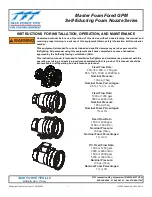
Flash Technology
Revision A - 2/13/2020
31
FTC 270 CONTROLLER INSTALLATION
FTC 270 CONTROLLER MOUNTING AND GROUNDING
Locate the FTC 270 controller in an area that will allow proper access to the enclosure. Turn the knobs to open the
door for internal access. A standard lock may be used on the knobs for additional security.
Use the following guidelines for mounting the controller:
Ensure that adequate space exists around the equipment for access during installation, maintenance, and
servicing.
The use of flexible conduit is recommended for all cable runs with the exception of the GPS antenna,
cellular antenna and jacketed ground wires.
Ground the controller using a 2 AWG insulated wire. Route all ground conductors down and away from
the energized equipment and ensure there are no bends smaller than an 8-inch radius. If installed
outdoors, the system controller should be bonded to the site grounding grid (via exothermic welding). If
installed inside a shelter or building, route the 2 AWG insulated ground wire to the nearest down-link and
attach using a compression fitting (c-tap).
FTC 270 CONTROLLER INPUT POWER CONNECTIONS
On the FTC 270 Controller, input power is connected to terminal block TB1. Mounted on TB1 is a Metal Oxide
Varistor (VR1) which reduces line surges and transients. Input power circuit breakers are also mounted on TB1.
Disconnect power from the FTC 270 before servicing circuit
breakers or MOV.
Flag Indicator on the 2-pole circuit breakers is clearly
marked with green OFF and red ON.
FTC 270 controllers are not sensitive to input power phase
and have an operational voltage range of 100-240 VAC,
50/60 Hz with no modification necessary to the input
power module.
Using a small flat tipped screwdriver, create an opening in
the terminal position before inserting the wires. The
provided RS-485 communication cable will terminate on
the right side of TB1. Ensure you match the color-coding
appropriately to avoid communication issues and improper
system operation.
















































